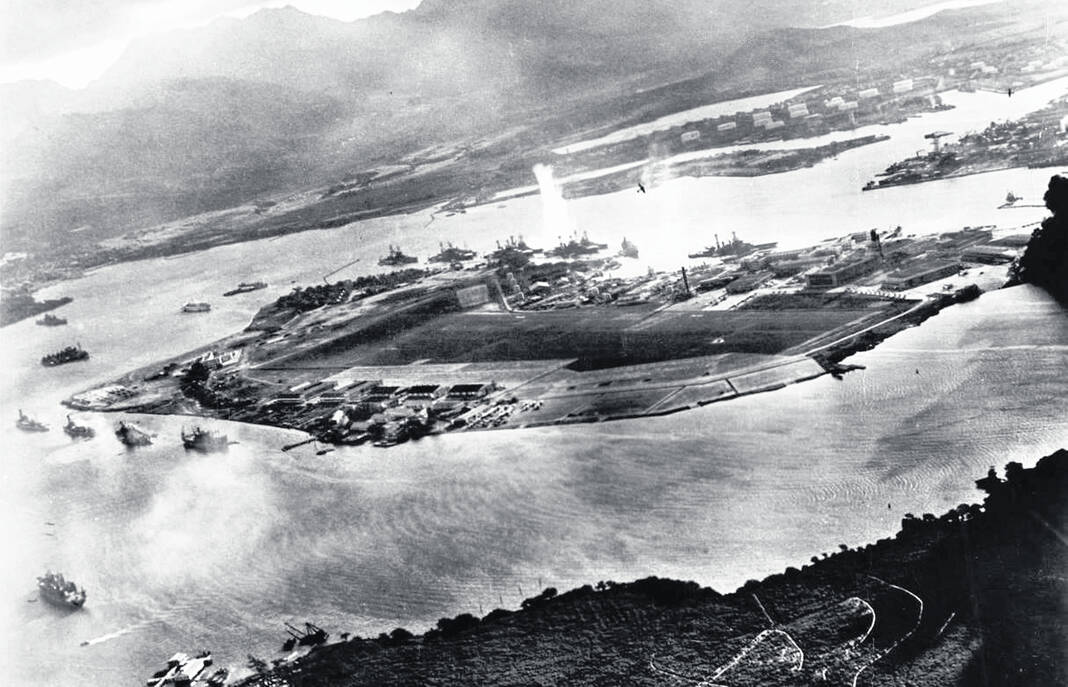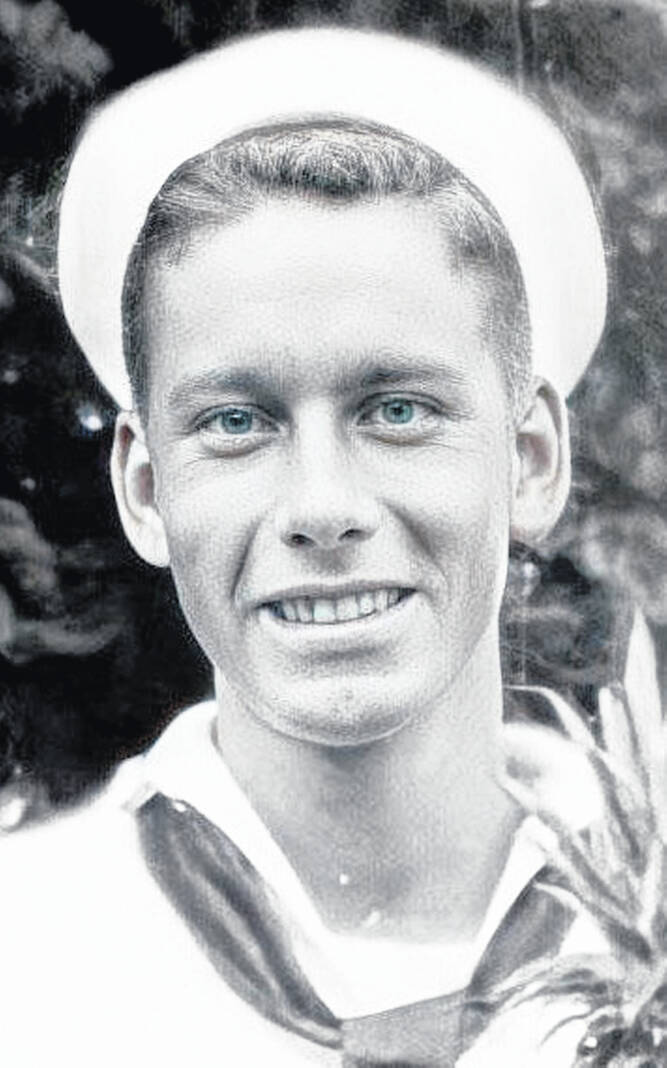

Eighty-one years ago, Joseph Warren Hoffman was killed on the USS Oklahoma during the attack on Pearl Harbor that set off America’s involvement in World War II, arguably the historical event having the most salient impact on present lives.
Hoffman will be returned to Ohio when his remains are buried in the Greenfield Cemetery with full military honors Saturday, Aug. 20. He was one of 15 sailors from Ohio who died on the ship.
Jerry Moomaw, Hoffman’s cousin from Texas, was the next of kin who was initially notified by the Navy that Hoffman’s remains had been identified. He has acted as the liaison for the funeral arrangements.
“All of my family are planning on coming,” said Jerry’s son John Moomaw. “My mother and father and my sister Jill are coming, and I’m bringing my son James.”
John Moomaw said the notification was strange because the family wasn’t very aware of the project to identify the USS Oklahoma crew members. “It was a little bit odd in that sense, but my father is a Navy veteran who fought in Vietnam, so it was kind of personal to him to hear about it, so we definitely wanted to attend,” he said.
Hoffman was a petty officer 1st class stationed aboard the USS Oklahoma and was 24 when he was killed during the attack. He was a multi-instrumentalist who held the musician rating in the Navy. As a Navy musician, he was among a select group of sailors who performed at ceremonies and for entertainment for civilian and military personnel.
Born in Lyndon, Ohio, Hoffman’s grew up in Chillicothe and enlisted in the Navy in Cincinnati on Jan. 10, 1938. Prior to being assigned to the battleship USS Oklahoma, he completed boot camp at Naval Training Station Great Lakes, Illinois and served on the submarine tender USS Argonne as his first permanent duty station.
He reported for duty aboard the USS Oklahoma on Oct. 1, 1938. As part of the effort to check Japanese aggression, the U.S. Pacific Fleet conducted exercises in the waters off of Hawaii beginning in May of 1940. After the maneuvers, the fleet remained in Pearl Harbor to provide more of a forward presence than was possible from the U.S. west coast.
The USS Oklahoma arrived in Pearl Harbor on Dec. 6, 1940 — one year and one day prior to the fateful attack — and spent the next several months participating in exercises and conducting patrols.
At the onset of the Dec. 7, 1941 attack, the USS Oklahoma occupied a berth in the famed “battleship row” off of Ford Island. The first of nine torpedoes to hit the ship struck just before 8 a.m. The ship quickly capsized from damage caused by multiple torpedoes.
When the ship was righted in 1944, the remains of 429 sailors, dubbed “The Lost 429,” were recovered. Of those, only 35 were able to be identified at the time of recovery.
The remains of 388 unidentified sailors and marines were initially interred as “unknowns” in two cemeteries. They were disinterred in 1947 in an unsuccessful attempt to identify more personnel. In 1950, all unidentified remains from the USS Oklahoma were buried in 61 caskets in 45 graves at the National Memorial Cemetery of the Pacific in Hawaii, a site nicknamed the Punchbowl.
In April 2015, the Department of Defense, as part of a policy change that established threshold criteria for the disinterment of unknowns, announced the unidentified remains of the crew members of the USS Oklahoma would be exhumed for DNA analysis with the goal of returning identified remains to their families.
The process began in June 2015, when four graves (two individual and two group graves) were disinterred. Identifications have been made by scientists from the Defense POW/MIA Accounting Agency.
As the identification process ended, 396 of the ship’s personnel have been accounted for. The 33 remaining service members were re-interred in a ceremony at the Punchbowl on Dec. 7, 2021, the 80th anniversary of the attack on Pearl Harbor.
After the identification of a sailor or marine’s remains, the Navy Casualty Office located at Navy Personnel Command in Millington, Tennessee takes control of the process.
“I think it’s great for our nation to know that this still goes on because even 80 years later it’s very important to those families to have some closure,” said Capt. Robert McMahon, who leads the Navy Casualty Office. “I wish for our country to know that we don’t forget. They are never forgotten, and we are going to bring them home.”
The following account comes from the Naval Personnel Command Public Affairs Office:
The USS Oklahoma was among almost half of the U.S. Pacific Fleet — consisting of 150 vessels — that lay at anchor at Naval Base Pearl Harbor Hawaii that Sunday morning when attacked by air forces of the Japanese Empire. Moored in Battleship Row beside the USS Maryland, the Oklahoma was among the first vessels hit.
The ship, under the command of Capt. Howard D. Bode, was actually supposed to be out to sea patrolling the Hawaiian Islands, but along with the other eight battleships at Pearl Harbor, the Oklahoma crew was advised there was to be an admiral’s inspection Monday.
When the attack began just before 8 a.m. Sunday, many of the crew were sleeping in their racks below decks and never made it up to the main deck.
At approximately 7:55 a.m. the first wave of Japanese aircraft struck the Oklahoma with three aerial torpedoes. The USS Oklahoma began capsizing as the Japanese planes strafed the deck with machine gun fire. After being struck by six more torpedoes, the Oklahoma’s port side was torn open and within 15 minutes of the fist torpedo strike, she had rolled completely over, trapping those crew members not fortunate enough to escape within her hull.
Men trapped inside started banging on the bulkhead trying to get the attention of passing small boats. On the Dec. 8 and 9, after cutting holes in the exposed bottom of the ship, 32 men were pulled out alive.
Banging continued through Dec. 10, but nothing could be done. The sound was coming from below the water line and the helpless sailors standing watch over the Oklahoma could only wait and listen until the banging stopped. In total, 429 USS Oklahoma sailors lost their lives.
The funeral service for Hoffman will be Saturday, Aug. 20 at 11 a.m. at the Ross County Veterans Memorial Park at 225 Park Street in Chillicothe followed by the burial at the Greenfield Cemetery.
Reach John Hackley at 937-402-2571.



